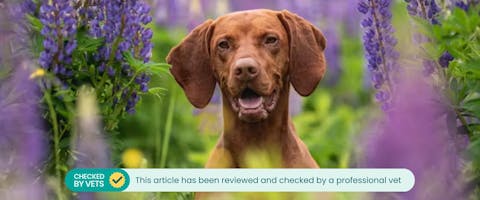Updated 13/06/2024
Sometimes, the most beautiful flowers are the most deadly. Aconitum goes by many other names including aconite, monkshead, wolf’s bane, and its full Latin name aconitum napellus or napellus aconitum (depending on where you’re from). It’s a common garden flower found in large bushels all over the world. It’s tough, resilient, gorgeous, but toxic.
With a dark purple plumage, its drooping petals resemble the hood of a monk (hence the nickname monkshood). But don’t be deceived by the innocent name…
Is aconitum poisonous to dogs? Well, let’s learn a bit more about this no-go pup plant, what aconitum poison can do to dogs, and what you should do if eaten by your drool baby.
Trending posts
Purr-use some of the top blogs our members have been loving this month- Top male dog names for your new furry friendGot a new furry family member in your pack? Check…

- Top female dog names for your new fluffy palWelcoming a new pooch into your family? Explore…

- 250+ gray cat names your silver feline will loveRecently welcomed a fluffy gray bundle of joy into…

- What are normal pet sitting rates?Discover the average pet sitting rates for animals…

- Unique dog names to stand out from the packDare to be different with our list of the best…

Is aconitum poisonous to dogs?
Yes, in fact, aconitum is also toxic for humans too. Like many poisonous plants for dogs, the aconitum has a deceptively beautiful flower, not too dissimilar to the foxglove, which is also toxic to humans and dogs. It’s a well-known toxin which has been used by us people for hundreds of years. There is no part of the aconitum napellus plant that isn’t poisonous, and every part of it can cause a severe reaction in less than an hour after being eaten.
Aconite poisoning in dogs
Although a common and foul-tasting plant, this doesn’t mean dogs won’t sometimes swallow part of the aconitum plant or aconitum flower. Ingestion is not the only way for your pup to be poisoned by aconite - it can also enter the bloodstream via a break in the skin or across mucous membranes. Even water that Aconitum plants have been soaked in could be toxic.
Aconite poisoning, if left untreated for too long, can cause permanent neurological damage and even death. So, it’s important to know what to do if you suspect your pup has eaten even a small part of a wolf’s bane plant, symptoms to look out for and understand how it can be treated.
Symptoms
Common symptoms of aconite poisoning from the aconitum plant include:
- Vomiting
- Tremors
- Weakness
- Shallow breathing
- Abdominal pain
- Frothing at mouth
- Pawing at mouth
- Heart arrhythmias
- Numbness
- Paralysis
- Seizures
Of course, every dog is different, so other concerning signs or changes in behavior should
Diagnosis
It goes without saying if you think your dog may have eaten part of an aconitum plant, even if they’re not showing symptoms you must take them straight to the vet. It’s always better to be safe than sorry. Your vet will be able to assess your pooch for poison symptoms.
If you saw your canine companion ingest part of the aconitum flower, its green leaves, or even part of its root, make sure that’s the first thing you tell the vet. They’ll run quick blood and urinary tests to check their white and red blood cell count, along with their other vitals, to work out how best to treat them.
For pet parents who aren’t 100% sure if their snuffle pup has swallowed some aconitum napellus, your vet will likely induce vomiting or an enema to check for any plant pieces to prevent further absorption from the digestive tract. The aconitum plant can take effect in less than an hour, so time is of the essence.
Treatment
Doggos who have ingested wolf’s bane will have to have a gastric lavage or stomach pump. This will clear their digestive passages of any other pieces of the aconitum plant to make sure no more poison is absorbed by their bodies.
Once the vet is sure they removed the plant, they will then give your pup a paste of activated charcoal. This stuff works by lining the stomach and binding to the poison in their tummies to prevent it from being absorbed into the bloodstream.
After all that, pups will be monitored for 24 hours along with an intravenous drip to rehydrate them, and any other extra vitamins they may have lost through the procedure. If caught early enough, there’s a high chance of survival. For dogs who have already developed more concerning symptoms of poisoning, they may require more intensive treatment or hospitalization.
Finally, be sure to give your brave pooch lots of rest and plenty of cuddles after such a traumatic experience.
Meet our veterinary expert, Holly
This article has been checked by veterinarian Holly Anne Hills BVM BVS BVMedSci. After graduating from the University of Nottingham, Holly spent two years working as a farm animal vet. She then spent some time traveling and volunteering in India, working at neutering clinics and with injured street dogs. Holly now works in small animal practice, and balances this with writing, volunteering with the comms team at Vet Sustain, and she is also a marine mammal medic!
If you’re a Standard or Premium TrustedHousesitters member, you have free and unlimited access to our 24/7 vet advice line, should anything happen to your curious canine. For those of you who aren’t yet members, you can still head to our Community Forum to connect with other pet parents. The Forum is there for our pet loving community to discuss their own experiences to spread the love and knowledge of pet welfare and care.

